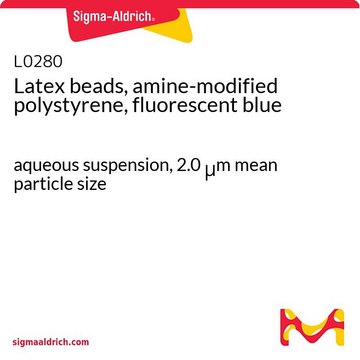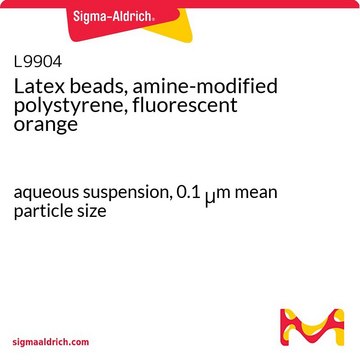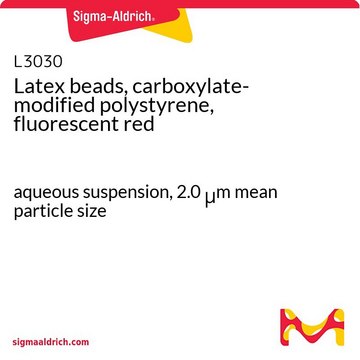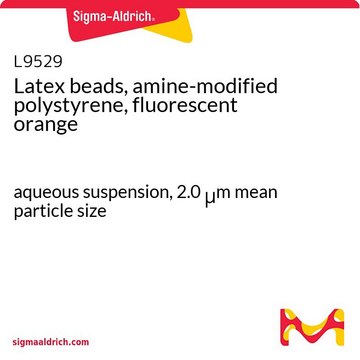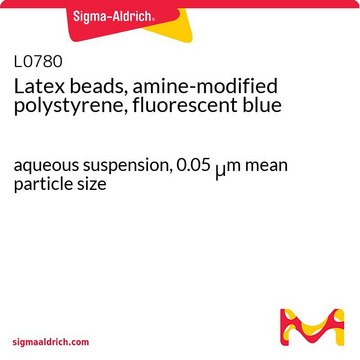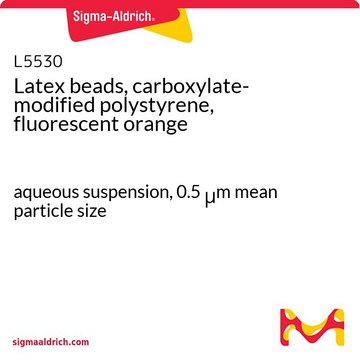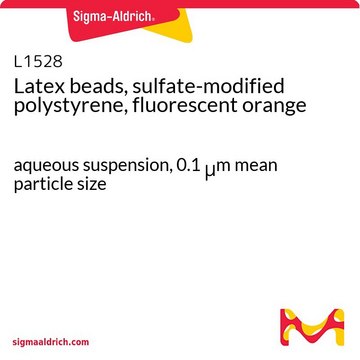L1030
Latex beads, amine-modified polystyrene, fluorescent yellow-green
aqueous suspension, 1.0 μm mean particle size
Se connecterpour consulter vos tarifs contractuels et ceux de votre entreprise/organisme
About This Item
Produits recommandés
Forme
aqueous suspension
Niveau de qualité
Composition
Solids, 2.5%
Technique(s)
cell based assay: suitable
Taille moyenne des particules
1.0 μm
Fluorescence
λex ~470 nm; λem ~505 nm
Application(s)
cell analysis
Vous recherchez des produits similaires ? Visite Guide de comparaison des produits
Application
Latex beads, amine-modified polystyrene, fluorescent yellow-green have been used:
- in the characterization of nano- and microplastics
- in tendon preparation to label tendon fascicles to enable precise localization of the tissue surface
- in phagocytosis assay to label spleen cells
Actions biochimiques/physiologiques
Polystyrene latex beads can be used to create latex agglutination systems. It can be used to study the transmission of Mycobacterium leprae, the causative pathogen of leprosy. These beads are also utilized to develop a method for mass screening for both pulmonary and extrapulmonary tuberculosis.
Code de la classe de stockage
10 - Combustible liquids
Classe de danger pour l'eau (WGK)
WGK 2
Point d'éclair (°F)
Not applicable
Point d'éclair (°C)
Not applicable
Faites votre choix parmi les versions les plus récentes :
Déjà en possession de ce produit ?
Retrouvez la documentation relative aux produits que vous avez récemment achetés dans la Bibliothèque de documents.
Les clients ont également consulté
Sean Spanik et al.
Journal of contaminant hydrology, 243, 103919-103919 (2021-11-12)
The transport of cationic amine-modified latex (AML) and anionic carboxylate-modified latex (CML) microspheres through a discrete sandstone fracture with mineralogical heterogeneity and roughness was studied. Two microsphere sizes (200 nm and 1000 nm), two ionic strengths (5 mM and 10 mM), and two specific
Ivan Gusachenko et al.
Biophysical journal, 102(9), 2220-2229 (2012-07-25)
Collagen is a triple-helical protein that forms various macromolecular organizations in tissues and is responsible for the biomechanical and physical properties of most organs. Second-harmonic generation (SHG) microscopy is a valuable imaging technique to probe collagen fibrillar organization. In this
James M May et al.
Archives of biochemistry and biophysics, 440(2), 165-172 (2005-08-02)
Since activated macrophages generate potentially deleterious reactive oxygen species, we studied whether ascorbic acid might function as an antioxidant in these cells. Thioglycollate-elicited murine peritoneal macrophages contained about 3 mM ascorbate that was halved by culture in ascorbate-free medium. However
Jing Liu et al.
Fish & shellfish immunology, 82, 136-146 (2018-08-14)
Clam Ruditapes philippinarum is one of the most important commercial aquaculture species in China. The haemocytes play vital roles in internal defense of the calm. In this investigation, classification and immune functions of R. philippinarum haemocytes were identified. The haemocyte
Fancong Kong et al.
Experimental and therapeutic medicine, 10(6), 2093-2101 (2015-12-17)
Microvesicles (MVs) in body fluids participate in a variety of physical and pathological processes, and are regarded as potential biomarkers for numerous diseases. Flow cytometry (FCM) is among the most frequently used techniques for MV detection. However, different handling methods
Notre équipe de scientifiques dispose d'une expérience dans tous les secteurs de la recherche, notamment en sciences de la vie, science des matériaux, synthèse chimique, chromatographie, analyse et dans de nombreux autres domaines..
Contacter notre Service technique

